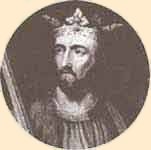 Edward III, the Confessor
Edward III, the ConfessorHouse of Wessex, Restored -- Reigned: 1042-1066 Died: 1066
Canute had placed the local control of the shires into the hands of several powerful earls: Leofric of Mercia (Lady Godiva's husband), Siward of Northumbria and Godwin of Wessex, the most formidable of all. Through Godwin's influence, Edward took the throne at the untimely death of Hardicanute in 1042. In 1045, he married Godwin's only daughter, Edith. Resulting from the connections made during Edward's years in Normandy, he surrounded himself with his Norman favorites and was unduly influenced by them. This Norman "affinity" produced great displeasure among the Saxon nobles. The anti-Norman faction was led by (who else?) Godwin of Wessex and his son, Harold Godwinsson, took every available opportunity to undermine the kings favorites. Edward sought to revenge himself on Godwin by insulting his own wife and Godwin's daughter, Edith, and confining her to the monastery of Wherwell. Disputes also arose over the issue of royal patronage and Edward's inclination to reward his Norman friends. A Norman, Robert Champart, who had been Bishop of London, was made Archbishop of Canterbury by Edward in 1051, a promotion that displeased Godwin immensely. The Godwins were banished from the kingdom after staging an unsuccessful rebellion against the king but returned, landing an invasionary force in the south of England in 1052. They received great popular support, and in the face of this, the king was forced to restore the Godwins to favor in 1053. Edward's greatest achievement was the construction of a new cathedral, where virtually all English monarchs from William the Conqueror onward would be crowned. It was determined that the minster should not be built in London, and so a place was found to the west of the city (hence "Westminster"). The new church was consecrated at Christmas, 1065, but Edward could not attend due to illness. On his deathbed, Edward named Harold as his successor, instead of the legitimate heir, his grandson, Edgar the Ætheling. The question of succession had been an issue for some years and remained unsettled at Edward's death in January, 1066. It was neatly resolved, however, by William the Conqueror, just nine months later. There is some question as to what kind of person Edward was. After his death, he was the object of a religious cult and was canonized in 1161, but that could be viewed as a strictly political move. Some say, probably correctly, that he was a weak, but violent man and that his reputation for saintliness was overstated, possibly a sham perpetrated by the monks of Westminster in the twelfth century. Others seem to think that he was deeply religious man and a patient and peaceable ruler. |
All rights reserved. For details and contact information: See License Agreement, Copyright Notice. |
 The penultimate Anglo-Saxon king, Edward was the oldest son of
The penultimate Anglo-Saxon king, Edward was the oldest son of